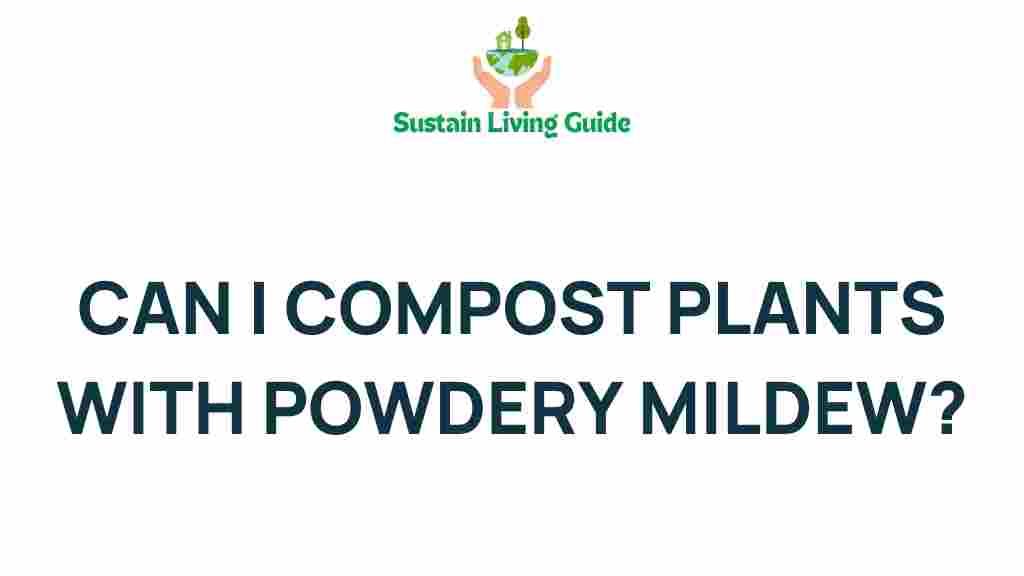The Composting Dilemma: Can You Safely Compost Powdery Mildew Plants?
Composting is an essential practice for gardeners and environmentally conscious individuals alike. It allows us to recycle organic waste, enrich our soil, and promote sustainability. However, when it comes to plants affected by diseases like powdery mildew, the question arises: can we safely compost these materials without spreading the disease? In this article, we’ll explore the intricacies of composting powdery mildew plants, providing you with the knowledge you need to make informed decisions about your compost pile.
Understanding Powdery Mildew
Powdery mildew is a fungal disease that affects a wide variety of plants, causing white, powdery spots on leaves and stems. This disease can weaken plants, reducing their growth and yield. It thrives in warm, dry conditions and can spread rapidly if not managed properly. Before deciding to compost infected plants, it’s essential to understand the implications of this disease.
The Importance of Composting
Composting is a natural process that transforms organic matter into nutrient-rich soil. It offers numerous benefits, including:
- Waste Reduction: Composting diverts organic waste from landfills.
- Nutrient Enrichment: Finished compost is rich in nutrients that benefit plants.
- Soil Improvement: Compost improves soil structure, drainage, and moisture retention.
- Environmental Benefits: Composting reduces greenhouse gas emissions and conserves resources.
The Risks of Composting Powdery Mildew Plants
When considering composting plants affected by powdery mildew, several risks must be evaluated:
- Pathogen Survival: Fungi can survive the composting process if conditions are not ideal.
- Spread of Disease: Composting infected plants may introduce pathogens to healthy plants.
- Quality of Compost: If not handled correctly, the quality of compost may be compromised.
Can You Safely Compost Powdery Mildew Plants?
The short answer is: it depends. Composting infected plants is a contentious topic among gardeners and composting experts. However, there are methods to safely compost powdery mildew plants, provided you follow specific guidelines.
Step-by-Step Process for Composting Powdery Mildew Plants
Here’s a step-by-step guide to help you manage composting powdery mildew plants safely:
1. Assess the Severity of the Infection
Before composting, evaluate the extent of the powdery mildew infection. If the plants are only slightly affected, composting may be viable. However, if the infection is widespread, consider alternative disposal methods.
2. Remove Infected Parts
Trim away the most affected parts of the plant before adding them to your compost pile. This will reduce the amount of fungal spores introduced into the compost.
3. Hot Composting
The key to safely composting infected materials is achieving high temperatures. Hot composting involves:
- Maintaining a compost pile temperature of at least 140°F (60°C).
- Turning the pile regularly to ensure even heating.
- Monitoring moisture levels for optimal decomposition.
These conditions can help kill off pathogens, including the spores of powdery mildew.
4. Add Carbon-Rich Materials
Mixing infected plant material with carbon-rich materials (browns) like dried leaves, straw, or cardboard helps maintain the right balance in your compost pile. This ratio of carbon to nitrogen (approximately 30:1) is vital for effective composting.
5. Monitor the Composting Process
Keep an eye on your compost pile during the decomposition process. Ensure it heats up adequately and remains turned regularly. If the pile cools down, it may not effectively kill pathogens.
Alternative Disposal Methods
If you’re concerned about the risks of composting powdery mildew plants, consider these alternatives:
- Bag and Dispose: Seal infected plants in a plastic bag and dispose of them in the trash.
- Burning: If local regulations allow, burning infected plants can be an effective way to eliminate pathogens.
- Municipal Yard Waste: Check if your local waste management offers yard waste collection services that can handle diseased plants.
Troubleshooting Tips
Even with careful management, issues can arise when composting powdery mildew plants. Here are some troubleshooting tips:
- Temperature Drops: If the compost pile cools down, turn it more frequently and ensure proper moisture levels.
- Odors: Bad smells may indicate anaerobic conditions. Turn the pile and add more browns to improve aeration.
- Insects or Pests: If pests invade your compost pile, consider adding more high-nitrogen materials to deter them.
Conclusion
In conclusion, composting powdery mildew plants can be done safely if proper precautions are taken. By understanding the risks, following best practices for hot composting, and monitoring the process, you can recycle your organic waste without fear of spreading disease. Remember that prevention is key—maintain good plant health and monitor your garden for signs of powdery mildew or other diseases. For more information on effective composting techniques, check out this helpful resource.
Whether you choose to compost or dispose of infected plants, your commitment to sustainable gardening practices contributes to a healthier environment. Happy composting!
This article is in the category Eco-friendly and created by SustainLivingGuide Team
